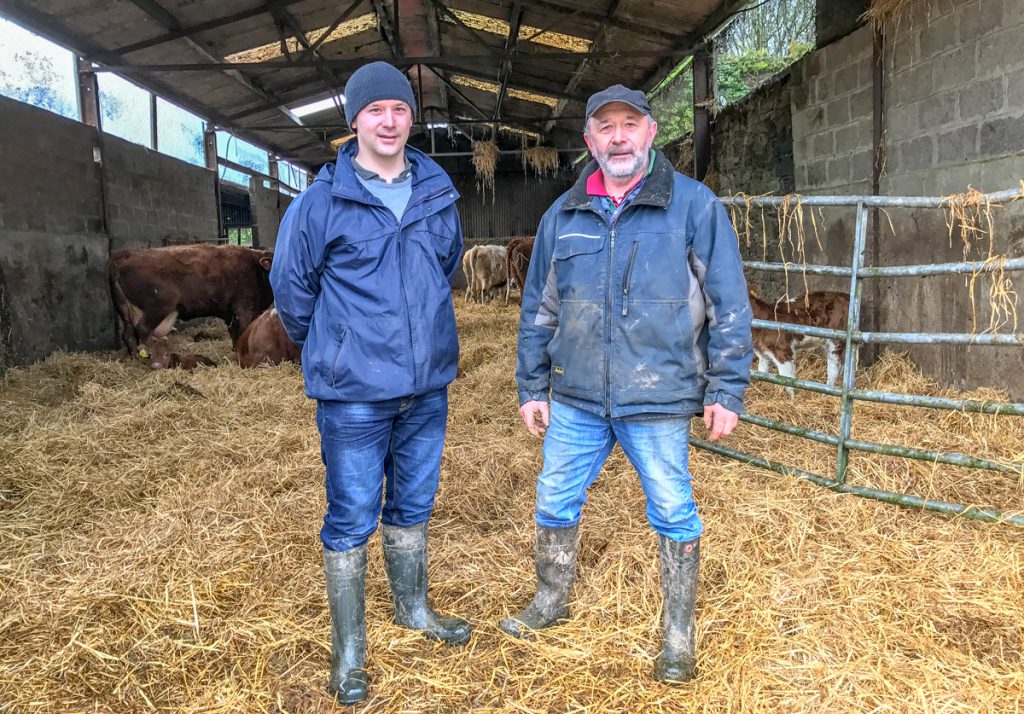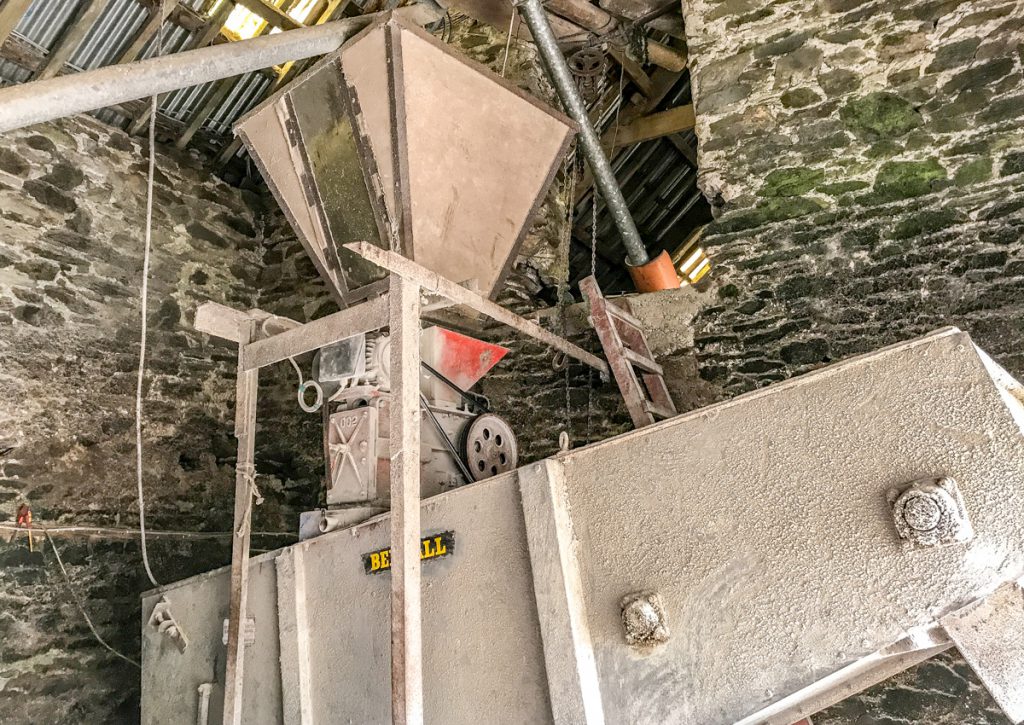Niall Nicholson farms in partnership with his father Billy just outside Crosshaven, Co. Cork. The first thing that strikes you when you walk onto the farm is organisation.
Niall comes equipped with silage results and diets in hand. In order to avoid any confusion, diets are written on boards above cattle pens. No stone is left unturned.
The Nicholsons’ farm is self-sufficient. All animals are reared on the farm and all forage is grown on it too. With the exception of minerals and soya – for protein – nothing else enters the farm gate.
It’s a busy period on the farm. The father-and-son team started calving their 120 suckler cows in mid-December and will finish up at the end of February.
Silage analysis is standard practice
Each year, three cuts of silage are made on the farm. 25ac of first-cut silage are often grazed beforehand. The main pit is also first-cut silage, which has not been grazed and is made from 45ac of grass. This silage was being used when AgriLand visited.
The second-cut silage pit has yet to be opened. About 100 bales are also made from surplus grass each year.
“If you don’t test your silage, you won’t know what you’re at. You’re just pumping rolled barley into animals and it’s not even needed. We test the pits every year before we open them. That way, we know what we have and how much it will cost us to feed cattle over the winter.
“The silage analysis came back very good this year. We were nearly too happy with it to be honest. We usually have one bad pit that we feed to the cows.
The big pit had a DMD (dry matter digestibility) of 74.4% and crude protein was 11.8%. The second cut was the best of the lot. It had a DMD of 76.3% and crude protein was 12.7%.
Cover crops
The cows spent much of the winter grazing the GLAS (Green, Low-Carbon, Agri-Environment Scheme) cover crops.
“We had the cows out a lot of the time on the stubble turnips and fodder rape mix, which was sown for GLAS. They were cleaning it out every time we moved them.
“The cows were out on December 1. They were lying back onto stubbles for the first two to three weeks. When the weather broke, we brought them in for the evening and fed silage. The feed was all leaf, it was cheap and it stretched the silage.
We’ll put yearlings out to finish the cover crop. They will be housed during the evenings and get silage.
Fattening bulls
The majority of the cattle came in at the end of November, but fattening cattle came in at the end of September.
“The bulls going for under 16 months will be sent to Dawn Meats. They came in at the end of September and were on rolled barley and soya. We had no beet at the time. They are now being fed twice a day. They’re effectively on an ad-lib diet.
“These bulls are costing us about €2.54/day to feed from January to April. They’re on 12kg of silage, 12kg of fodder beet, 8kg of barley and 2kg of soya. Minerals are mixed in with the soya. There will be some fit to go before April. They’ll be weighed next week.
“The yearlings are on silage, 1.25kg of soya and 5kg of beet. They’re not receiving any rolled barley.”
As soon as the cows calve, they get beet to get used to it and it’s built up slowly. Niall explained that, with cows, ration is only fed to first-time calvers or a cow that has twins to boost milk production.
Feeding and growing beet
The Nicholsons grow beet on their farm. A contractor sets and harvests the crop and Niall and his father spray the crop during the season. They grew Magnum this year.
“We’ve grown various varieties over the years, but we can’t find one to compare to Magnum. It has always given us great crops anyway.
“We grow our own beet and we start harvesting it in late October. We pull the headlands and open up the fields. We pull the rest in one or two goes in November.
“In the last couple of years, the weather has tended to break in November and it has worked out well for us because we’ve had plenty of beet in the yard.
We have some farmers borrowing beet from us at the minute and they’ll give it back to us when they pull their own. We’ll have fresh beet then.
“If grass is tight in the spring, the beet will stretch it. We feed it under the wire.”
Rolling barley
Niall continued: “We have about 100ac of tillage. We grew winter barley last year. It will be all spring barley, fodder beet and temporary grass this year. We grow our own barley and we store it. We keep 96t of barley in bins on the farm.
“We cut it at about 19% moisture content and it goes into the shed with air blowing up through it. It’s dried down to 15-16%. We roll the barley from the bins.
“We grow a small bit of malting barley and that goes to Dairygold. Any excess feed barley will also go to Dairygold. We keep all of the straw. We grew Planet, Propino, Paustian and Mickle this year.”
Beef Data and Genomics Programme (BDGP)
“We’re in the BDGP, so we’re using 4 and 5-star heifers,” Niall stated. He says that it has really improved their farming system.
“The calves are coming to higher weights faster. We have 40 bulls to go under 16 months. In other years, we would have 30. They’ve higher weights from the milk.
The calving interval on the farm is 359 days.
“We synchronised the heifers this year. I’m doing the AI myself. We tend to go for high maternal index cows – the 4 and 5-star rated cows. The bulls are Simmental, Saler, Limousin and Charolais.
We’ll start breeding on March 1. They’ll be either going to grass or coming in and out at that time. The AI fits in well because they’ll be coming in and out of the yard.
“When we synchronised the heifers, we kept them in until late March. If they weren’t in calf at that stage, they were let to the bull. We leave the bulls with the heifers for eight weeks and with the cows for 12 weeks.”
Flying to Brussels
Niall is a member of Macra na Feirme. He is currently taking part in the Young Beef Farmer Sustainability Programme with Macra and Dawn Meats. He has sat on Macra’s Ag Affairs Committee and is finishing up a term on CEJA – the European Council of Young Farmers.
“If you listened to everything that’s going on outside the gate, you’d get very disheartened. I go to Brussels a lot with CEJA, they’re talking about raising the Mercosur limit to 99,000t. That will decimate beef farming here.
“They can produce beef over there for €2.31/kg. We’ve a long way to go to reach that. If we were able to farm to the same regulations as them (the Mercosur countries), we’d be on an equal playing field.
“One thing about being over in Europe is you know what’s coming and you get a good handle on markets and what’s affecting beef price.
“Last year, there was a huge impact on the beef price from the dairy cull in Europe. Across Europe – in places like the Netherlands – there was a huge cull of dairy cows, which had a knock-on effect on the Irish beef price.”
Being part of a discussion group has also helped the family’s business.
“Meeting like-minded people helps. Dad was in the discussion group for a long time. The East Cork Harbour discussion group was there long before KT (Knowledge Transfer) groups were around. It’s a big area, as Co. Cork is predominantly dairy. It ranges from here in Crosshaven to Kinsale and Middleton.
The information you get is invaluable, such as seeing other farms and what you could do to improve or speed up things on your own farm.
Although many young farmers have been tempted to make the switch from beef to dairy, Niall hasn’t been tempted to switch allegiances.
“I enjoy beef farming and breeding beef cattle. We’re doing everything here apart from milking the cow,” he said.








